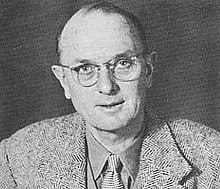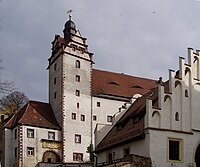Christopher Hutton

Christopher William Clayton Hutton (1893–1965) known to his colleagues as 'Clutty' [1] was an intelligence officer who worked for MI9, a subsection of British Military Intelligence. During the Second World War, he was hired by the War Office to create escape and evasion gear for British servicemen and to design the methods by which escape kits could be sent to prisoner of war camps.[2][3]
It is estimated that up to 35,000 British and other Allied troops who managed to escape and make their way back to Allied territory did so with Hutton's maps and other equipment.[4][5]
First World War
Hutton served as a pilot in the First World War[6] and was described as a forceful character who worked ceaselessly to overcome both technical and bureaucratic obstacles when inspired by an idea.[4]
Escape and evasion equipment
Hutton was interested in magicians and escapologists[7] and was responsible for the design of escape and evasion equipment for British troops, as well as items for use by the French Resistance.[8] When equipment was issued in advance as a contingency plan it was referred to as Pre-capture and hidden in the uniform. Post-capture aids were designed for use by captured POWs. In 1942, Hutton, as Clayton-Hutton, published a top secret booklet called Per Ardua Libertas.[9] This contained examples of each escape and evasion map produced up to that time, and was used by American Intelligence officers researching the topic.
Cloth maps
The invention of the cloth map, otherwise known as an escape and evasion map is credited to Hutton, who considered maps to be ‘the escaper's most important accessory’.[10] The idea was that a serviceman captured or shot down behind enemy lines should have a map to help him find his way to safety if he evaded capture or subsequently escaped from detention. He met the mapmakers John Bartholomew and Son Ltd. in 1940, and Bartholomew supplied maps of Germany, France, Poland, Italy, Austria, Switzerland, Belgium, the Netherlands and the Balkans, waiving all copyrights to the map data in support of the war effort.
Once he had the cartographic source, he needed a medium onto which he could print the map. This medium needed to be quiet to unfold, would not disintegrate when wet, maintained its integrity when folded at the crease line and could be concealed in very small places. He first attempted to print on a silk square adding pectin to the ink so that it would not run or wash out when put in water. He went on to print escape maps on silk, man-made fibre and tissue paper. The tissue-paper map was made from mulberry leaves and had the texture of onion skin but with extreme durability. It could be balled, put in water and soaked, and then flattened without crease, fading or disintegration. It could be folded up in such a way that it would occupy a very small space, such as inside a chess piece or a record.[11] Most maps were printed double-sided to increase their usefulness.[6]
Maps, along with other escape equipment, were carried by aircrew.[10] By the end of the war, over 400,000 escape maps had been printed.[12]
Compasses
Hutton approached the instrument makers Blunt Brothers, who came up with a number of tiny compasses so small, they could be secreted in the back of a button.[13] Aircrew uniforms contained one unscrewable button with a compass inside. These buttons had reversed screw threads so that when prison guards tried to unscrew the buttons they tightened them instead.[13] When these were discovered, other versions were invented, including a magnetised razor blade on which the G of ‘Gillette’ always pointed north when the blade was hung on a thread. From that point on, all razor blades were magnetised.[12][13]
Uniforms and clothing
Blankets were sent with clothes patterns drawn in invisible ink. These would become clear when soaked in water, enabling escapees to stitch them together to make civilian clothing, once they had escaped.[3] Uniforms were intended to be converted easily to look like civilian clothing.[4]
Flying boots
Hutton designed flying boots with hollow heels to hide maps and escape equipment. Flying boots were designed to be converted easily to look like civilian shoes.[4] They consisted of wool-lined shoes onto which were stitched zip-up leggings. A knife was provided in one leg to cut away the leggings[8] and the top sections could be put together to form a waistcoat.[12]
Escape kits
Hutton designed escape kits in a small cigarette tin designed to carry a small supply of condensed food and foreign currency.[4] The tin also contained razor blades, water-purifying tablets and a rubber water bottle. By 1941, all British aircrew carried these.[12]
Delivery of escape equipment

Hutton was also responsible for the delivery of escape kits to POWs. The Geneva Convention allowed prisoners to receive parcels from families and relief organisations. These were dispatched through a number of fictitious charitable organisations, created to send parcels of games, warm clothing and other small comforts to the prisoners.[9] One of the major problems of captivity was boredom, and games and entertainments were permitted, as the guards recognised that if the prisoners were allowed some diversions, they would be less troublesome.
Games manufacturer Waddingtons helped by supplying editions of its Monopoly board game, and other games, although to date, no examples of any such Monopoly boards have surfaced. No samples were kept for record purposes in either Waddington or the War Office archives and the pictures of such boards currently available are all modern reproductions.[14] Snakes and ladders, table tennis, chess sets and playing cards were used to smuggle in escape kits with hidden maps and other equipment.[3][5][9]
Red Cross parcels were not used because of concerns the Germans would stop these reaching the prisoners if they discovered items hidden in them.[4] The escape kits are credited with helping 316 escape attempts from Colditz Castle, which saw 32 men make it back home.[3]
In the Media
Hutton's role during the Second World War was highlighted on the popular BBC Quiz QI episode 8 Series G "Germany" on 15 January 2010.[15]
See also
References
- ^ "Christopher Clayton-Hutton". Special Forces Roll of Honour. Retrieved 9 June 2011.
- ^ "Christopher Clayton-Hutton". Special Forces Roll of Honour. Retrieved 9 June 2011.
- ^ a b c d "The chess set designed to help POWs escape". Daily Mail. UK. 30 November 2006. Retrieved 10 June 2011.
- ^ a b c d e f Debbie Hall. "Escape and evasion maps of World War 2". British Library Board. Retrieved 10 June 2011.
- ^ a b KI MAE HEUSSNER (18 September 2009). "Get Out of Jail Free: Monopoly's Hidden Maps". abcNews. Retrieved 10 June 2011.
- ^ a b "ESCAPE MAPS". California Map Society. Retrieved 10 June 2011.
- ^ Pitchfork, Graham (2003). Shot down and on the run: the RCAF and Commonwealth aircrews who got home. National Archives UK. ISBN 1-55002-483-3.
- ^ a b "Escape Boots – Artefact of the Month". Museum of Transport and Technology, New Zealand. May 2006. Retrieved 10 June 2011.
{{cite web}}: Italic or bold markup not allowed in:|publisher=(help) - ^ a b c Alan Duke (Fall 2009). "Table Tennis as an Escape Aid" (PDF). The Table Tennis Collector. Retrieved 10 June 2011.
- ^ a b "Secrets, Security and Escape: 1939–1945". Exhibitions-Cambridge University. Retrieved 10 June 2011.
{{cite web}}: Italic or bold markup not allowed in:|publisher=(help) - ^ "History of Fabric Map production". Silkmaps.com. Retrieved 10 June 2011.
- ^ a b c d "The Great Concealer". Secretbritain.com. 17 September 2009. Retrieved 10 June 2011.
- ^ a b c Secret Britain: The Hidden Bits of Our History By Justin Pollard
- ^ "Reaction of Harold Lee, UK Monopoly researcher". Retrieved 31 December 2012.
- ^ https://www.youtube.com/watch?v=Ie5ipdZhIOc
